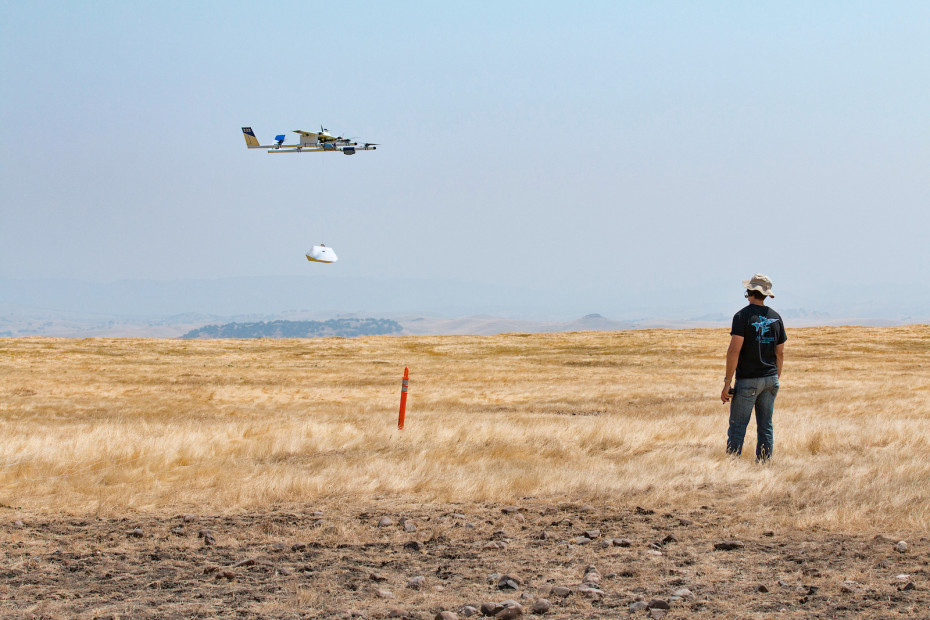
On a cold morning in February 2015, a group of men left the spacious Google X headquarters in Mountain View, California, before daybreak. They traveled more than two hours east to some trailers parked in the middle of nowhere, on private ranch lands in California’s Central Valley.
The men were there to test experimental drones for Google’s celebrated research-and-development group, known as Google X (the group now calls itself simply “X”). The work was grueling and involved 10- to 12-hour days of physically demanding labor in the extreme temperatures of the Central Valley, outside the town of Merced.
The men had complained to their supervisors about the hours in these conditions, but they felt their requests were largely ignored.
And on this day, their complaints turned into terror. One of their team members, a man in his mid-50s, collapsed on the job. He fell to the ground and jerked violently, as if he was crawling.
The incident was caught on the field video. Miles from anywhere, his coworkers called an ambulance and drove as fast as they could to meet it en route. He was taken to a local hospital and held overnight.
Some people at Google X say he had a heart attack. Others say it was a grand mal seizure. Word of the incident spread throughout the company, with rumors swirling that it had been caused by exhaustion and stress, multiple sources told Business Insider.
While the man’s health recovered, his job at Google did not. After taking a couple of months’ leave, he requested a transfer to a less physically demanding role within the team or elsewhere at Google X. Instead, he was sent back out into the field, essentially demoted, sources say, and eventually pushed out of the company.
We have changed the name of the person who experienced this medical emergency to “Joe,” because he declined to give us a statement and requested that Business Insider not publish his name. But half a dozen people familiar with this incident shared details, including photos and emails, with Business Insider.
Some members of the Project Wing field team painted an alarming picture of hostile work conditions driven by engineers and managers back at headquarters who scheduled the group to conduct loads of tests, thereby producing loads of data, despite the long hours outdoors that such a schedule required.
What’s more, the field crew found much of their feedback and expertise on how to improve their circumstances discounted or ignored, in part, some say, because their backgrounds in the military were allegedly viewed disdainfully by others on their team.
“It was unconscionable” to make that team “work that hard,” one person told us about this team’s experiences.
The story of the drone crew reveals some of the problems that have plagued Google’s efforts to build advanced delivery drones, and it illustrates one of the risks when Silicon Valley’s worship of workaholism and data crash into real people doing physically demanding jobs. It’s a dangerous dynamic as companies like Google, Facebook, and cash-rich startups expand into new industries, from aerospace and delivery to space exploration and self-driving cars.
It also comes at a time when the work conditions and cultures across America’s tech companies are under scrutiny, in the wake of sexual-harassment allegations at Uber.
“It’s just not right in Silicon Valley,” one person told us.
The Valley is grappling with its reputation for being a “bro” culture dominated by entitled, young men with degrees from prestigious universities. It’s a mentality that can result in exclusion and the victimization of a broad swath of people, from women and minorities to older men and even veterans.
“This was super wrong. Those folks were harassed in an incorrect manner,” one person said of the Project Wing flight testers. “Those people, the ex-US military folks, their team discriminated against them very bluntly.”
A hot Google X project hits turbulence
For about five months, Joe had been a flight test engineer for Project Wing. The Wing team was developing a delivery drone, racing against Amazon and drone makers like DJI to invent what could become a massive new market, delivering everything from food to medicine to consumers’ doorsteps.
The team had some successful and highly publicized tests in Australia the year before, and got the attention of Google cofounder Sergey Brin.
Brin even “moved a desk into the bull pen of Project Wing where everyone works,” one person said. Google X was his brainchild and he often kept tabs on its projects.
But things weren’t going so well.

Image Credit: Google
The Project Wing drone was based on a single-wing design that took off and landed upright, like a helicopter. But the drone kept toppling over on its nose.
To solve the design problems, the flight-testing crew’s supervisor, Tony Nannini, wanted to do what Google managers often do in such situations: Collect loads of data.
Nannini — who worked in the corporate offices in Mountain View, California, not in the field — crafted a schedule for “thousands of tests,” one person told us. For Joe and the rest of the flight-test crew, that meant 10- to 12-hour days outdoors flying the drones, sometimes in freezing temperatures or while standing in fields of two-inch-deep mud and cow excrement or, at other times, dealing with the Central Valley’s infamous 100-plus-degree heat.
While Joe was the only person we know of to be hospitalized, other people also complained of exhaustion and of difficulty working in the harsh conditions, particularly the heat, according to documents viewed by Business Insider. Although the worksite included an air-conditioned trailer for the crew, the work of flying drones required spending long periods outside, sources said.
The crew also complained that the work schedule was so demanding, with days spent away from home, it left them little time or energy for a home life. And while they were able to take advantage of some of Google’s perks (one person mentioned Google’s free drop-off/pick-up laundry service), they were unable to enjoy most of the benefits their coworkers had, such as social gatherings, lectures, and the like.
Military people and the way they think
Several people we spoke with said that Joe and the flight-testing crew at Project Wing seemed to be treated poorly in part because they were labeled ex-military. Joe was not actually a veteran but had worked as a civilian for the military, people told us. The team included several other retired and former military folks.
There were conflicts between the flight-testing crew and their immediate supervisor, Nannini, as well as the head of the project at the time, Dave Vos, according to emails shared with Business Insider.
From the testers’ point of view, they had loads of experience with sophisticated aircraft. They wanted clear rules, better safety protocols, and reasonable work expectations from the Project Wing managers. At the same time, some members of the flight-testing crew felt like their expertise on how to accomplish their mission was being dismissed, people told us.
In contrast, some of the team’s managers felt as if the crew’s skills with combat airplanes and military drones made them somewhat overqualified and their ideas overkill for the task at hand, according to a person close to the company.

Image Credit: Google/YouTube/Project Wing
It was a disconnect between two groups with very different mentalities about how to get things done.
Tension arose. A project manager from headquarters allegedly made a disparaging comment to the crew about military people and their ability…

